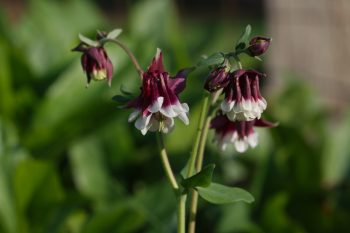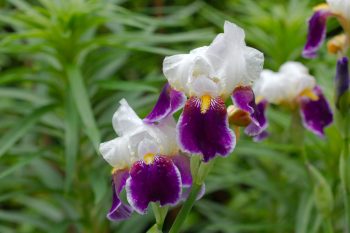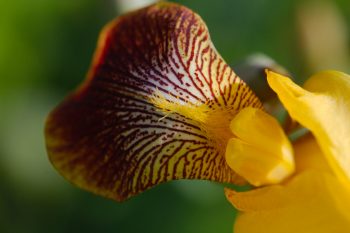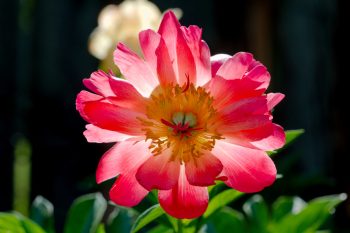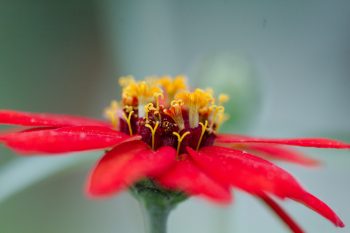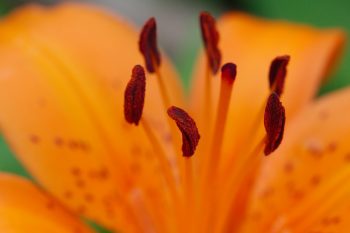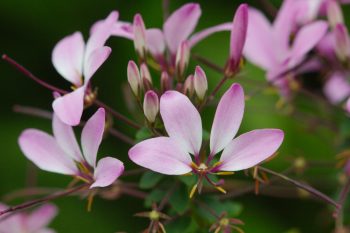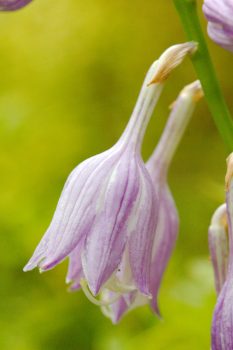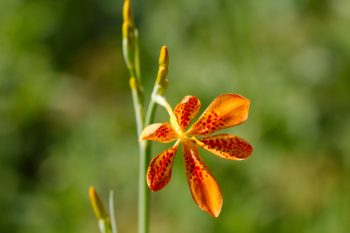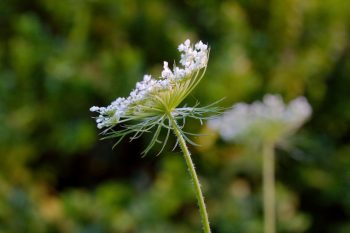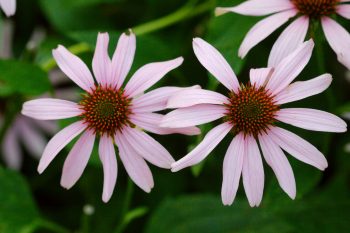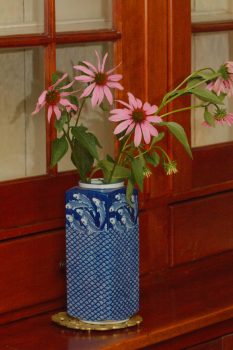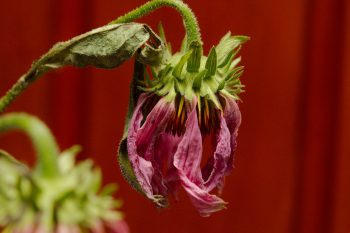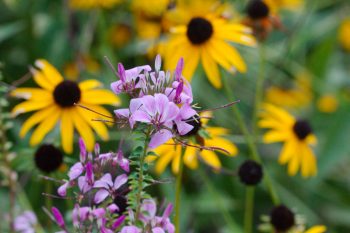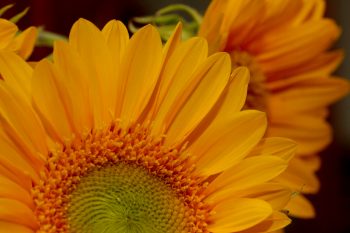There are columbine (Aquilegia species) scattered around our yard. Most of them are self-seeded volunteers and most of them are this dark, rather compact-flowering variety that seems to come true from seed. I don’t know what its origin is, whether we brought it here or it’s a natural hybrid from some that we had, but it’s quite successful, coming up year after year. It isn’t the most colorful columbine you’ll find, but it’s nice enough and I’m not going to turn down a zero-effort, flowering perennial like this.
Tagged With: Blooms
Columbine (Aquilegia)
Rosa rugosa ‘Roseraie De l’Hay’
I’m not sure what happened last year but for some reason, most of my roses died. One of them, a pink flowered R. multiflora hybrid, isn’t quite gone, with one branch left. This R. rugosa named ‘Roseraie De l’Hay’ also has some life left in it. Nevertheless, there’s a fair amount of dead wood to prune out. ‘Blush Noisette’ appears to be completely dead. It was never a very vigorous shrub but for it to simply die completely was unexpected. I lost my ‘New Dawn’ last year, but that I had to dig up because of rose rosette disease, is caused by Emaravirus species of virus.
Korean Lilac
Quite a few years ago, my dad happened to see an ad for something called The Seed Guild. If you bought an annual subscription, they would send seeds collected (with permission) from botanical gardens and arboreta around the world. One of the little packets of seeds that I got were labeled as Korean Lilac. At least that’s my memory. If I have it written down somewhere I certainly don’t know where. I also don’t know if it was Syringa meyeri, which is what is usually referred to as Korean Lilac or if it was some other, lesser known species. In any case, I had it growing in a container for many years and then when we moved here I put it into the ground. The deer ate it back one year but it’s doing pretty well now and for the first time has bloomed. The flowers are quite pale, not the lilac that we think of when we think of lilac. Nevertheless, they are a pretty pink, especially from a distance, where the color is more visible.
Bearded Iris
The irises have begun to bloom. We basically have two sets of tall, bearded iris. There are these purple and white type and another that are mostly yellow. They are both quite lovely and we could do worse than have them. That being said, we could do with a little more variety. We also have other types of iris, most notably Siberian iris (Iris sibirica) and English iris (Iris latifolia). Some of these bloom later and they are both much smaller, both in terms of overall height and in size of bloom, than the large, bearded varieties.
Peony ‘Coral Sunset’
In the fall of 2014 I bought three peonies called ‘Coral Sunset’ from John Scheepers (https://www.johnscheepers.com/). I planted them amidst the pachysandra along the back of my garden. The first spring there was only evidence of one of them. The next year, two. Now all three are coming up through the pachysandra and each of them bore a single bud. This is the largest and the first of them to bloom. I must say, they are worth the wait. One great thing about peonies is that they are long lived and they continue to grow into larger and larger clumps. These three should eventually grow together into one massive clump that will be wonderful in bloom. For now, I enjoy the solitary flower.
Yellow Iris
A few days ago I mentioned that we had two varieties of large, bearded iris in our garden. The one photographed then was purple and white. This is a detail of the other one, which is mostly yellow with brown falls (as you can see). They are not quite as large as the purple and white flowers but are still quite striking. This one is growing just inside the fence to the back yard. Well, what’s left of the fence. It’s an old post and rail fence and the wood is rotting and it’s falling down. A few weeks ago I took down the better part of it and I’ll probably finish the job before too long.
Peony ‘Coral Sunset’
I know I’ve already posted a picture of this plant this spring. In fact, it was only four days ago. Nevertheless, The second of the three peonies that I planted in 2014, named ‘Coral Sunset’, was blooming and had the late afternoon sun shining through it. I just couldn’t resist another picture of this wonderful flower. With one bloom per plant, we’re basically done for the year with these three. But they were worth it and I’m already looking forward to a total of four or five flowers on the three plants next year.
Zinnia
It was another foray out onto the driveway for pictures this evening after work. Today was relatively quiet, coming home from work and not going out again, which was a treat after the week we’ve had. Things will get busy again tomorrow as William and Beth are driving down from New York and we’ll be going through a few things in the basement at Margaret’s house. I stopped at the store and bought some ground beef and ground pork. When I got home I made some meat sauce to have with tortellini and also made a meat loaf to slice and reheat for meals in upcoming days.
Asiatic Lily
The Asiatic lilies are in bloom around the yard. This one is in a container on the back patio but there are a bunch in the front garden, as well. We worry about them being eaten by rabbits or deer but this time of year, fortunately, there is a lot for them to eat and that means less chance of them finding these. We have a lot of rabbits this year. I’ve seen as many as four at once in our front or back yard. The seem to mostly be eating clover, though, and we have plenty of that to go around.
Cleome ‘Señorita Rosalita’
Commonly known as spider flower Cleome is a fast-growing, tender perennial grown here as an annual (it’s only hardy in USDA zones 9 and 10). This variety, ‘Señorita Rosalita’, is “noted for having no thorns, no unpleasant aroma, no sticky foliage, no seedpods and better disease resistance” (Missouri Botanical Garden Plant Finder). We love it and it’s been a regular feature in a container on out back patio. We really should plant more of them, as they always perform very well and bloom basically all summer from mid-June well into October or November.
Hosta La Vista, Baby
The genus Hosta has about 70 species native to Japan, Korea, China and eastern Russia. They are shade loving perennials grown mostly for their foliage but they have nice, if somewhat understated flowers, as well. The name Hosta is in honor of of Austrian botanist Nicholas Thomas Host (1761-1834). My parents had these in their garden and growing up I knew it as Funkia. That’s because the genus was renamed to that in 1817 “in honor of botanist Heinrich Christian Funk under the belief at that time that Hosta was an invalid name.” Early in the 20th century the name was switched back but the plants are still referred to as Funkia by some (including my parents, evidently).
This one is growing in a container just outside our front door. There are generally two pests that eat Hosta plants. Slugs can do significant damage to them, eating holes in the leaves. In our garden, that’s generally not so destructive that we worry about it, although it can make the leaves a little less attractive. The other culprit is deer, who really seem to love Hosta leaves. Although we see deer in our yard and often see signs of their presence, they don’t seem to come too close to the house. So, we keep the Hostas close and that seems to be enough. We also put up deer repellent although I don’t actually know how much help that is. It certainly doesn’t do any harm.
Iris domestica
This is Iris domestica, often called blackberry lily or leopard lily and formerly known as Belamcanda chinensis. It’s a perennial plant that we have in various places in our garden. We gather the seeds most years and spread them in areas we would like it to grow, although I don’t know if we’re doing as well as the birds when it comes to actually spreading it. As you can see, it has vaguely lily-like flowers and they are quite lovely. They each last a day but they are born in clusters, blooming one after the next for quite a while. In case you were wondering, the genus name Iris comes from the Greek goddess of the rainbow.
Queen Anne’s Lace
My grandmother carried a bouquet of Queen Anne’s lace (Daucus carota var. carota) at her wedding. For their 50th anniversary party we gathered bucket loads of the stuff from empty fields and had it all round the room. You are probably familiar with the flowers, as it’s a pretty common plant all across the United States and bordering provinces of Canada as well as Europe and Asia. This is the wild carrot from which our cultivated carrot descended. It is reported to have been first developed in Afghanistan. It is a biennial plant, blooming in their second year.
Purple Coneflower
It’s been a good year for the purple coneflower (Echinacea purpurea) in our yard. Of course, it’s been an even better year for the weeds. With most weekends at least partly devoted to dealing with one or both of our mom’s houses, we’ve spent a lot less time in the garden this year. There is bindweed (Convolvulus species) everywhere and it’s running riot. In particular, along the back fence and the garden along the south end of the house are both totally out of control. There is significant pokeweed, goldenrod, various thistles, and even a few trees (zelkova, elm, maple, and ash). But there are some blooms that were intended, as well, including this coneflower.
Purple Coneflowers
Cathy brought some coneflowers in this evening to put in a vase in or dining room. Actually, they got knocked over when she was cutting the grass so she figured we might as well enjoy them as they die. I think they look really nice against the rich brown of this china cabinet. As you might be able to tell, the china cabinet is empty. We’ll put things in it but we haven’t gotten around to it yet. For now, the things that could go in it are in boxes and taking up space that could be used in better ways. But finding them and figuring out what we want where is a bit too much for us right now.
We don’t bring flowers in very often but I’m always glad when we do. One of the nicest photos I’ve taken, actually, is a vase of flowers, mostly roses, that Cathy arranged. It was sitting on our kitchen table and the late afternoon sun was coming in and lighting it from the side so the background went fairly dark and the flowers glowed nicely. I’ve made a few prints of that one, taken in 2010, and it’s been fairly popular. I don’t think this one will win any awards but I do like the colors and it’s a relaxing picture, to me.
Wilting Coneflower
Ten days ago I posted a picture of purple coneflowers in a blue and white vase against the dark cherry of a china cabinet. I was a little surprised by the relatively warm reception it received. Those same flowers are now a little bit past their prime. This is one of them, drooping and a little faded, but still quite lovely in its own way. Of course, we all want to be the strong, beautiful flower, blooming where we are planted. But that’s fleeting, as it is written, “As for man, his days are like grass; he flourishes like a flower of the field; for the wind passes over it, and it is gone, and its place knows it no more.” (Psalm 103:15-16 ESV) But even his days are not all full bloom. We start as a small sprout (metaphorically speaking), grow, (hopefully) bloom, and (even more hopefully) bear fruit. But then we grow old and begin to fade, like this flower. That, too, can be beautiful. Lord, help me to grow old gracefully.
Deep Orange Zinnia
In the small garden where the county once had an oak tree, down by the road, Cathy has been growing mostly annuals each summer. We got a lot less done in the yard this year but she did manage to get a bunch of zinnia and marigold plants in the ground. There is Pachysandra terminalis already growing around the bed but she has kept the center, where the tree was, clear for her annuals. There is also Conoclinium coelestinum (Blue Mistflower), a slightly invasive herbaceous perennial, but she pulls out enough each year to keep things balanced. The blue of the Conoclinium goes well with the yellow and orange of the zinnias and marigolds.
Cleome and Black-eyed Susan
We really should plant more of this. The pink flowers in the foreground are Cleome ‘Señorita Rosalita’ and they really are lovely. They also bloom pretty much continuously all summer and well into the fall. We have just a few plants growing in a container on the back patio. They are pretty much overwhelmed by the yellow of the black-eyed Susans that are all around. I think if we had a larger container or two filled with Cleome, it would be pretty nice. I should make a point of buying a few packets of next year and getting them started early.
Sunflowers
These were given to Margaret for her 92nd birthday and are quite pretty. We have them in a tall, blue vase that we were given as a wedding present and they are photographed here in front of the cherry china cabinet that I’ve used as a backdrop a few times since we moved it to our dining room. Sunflowers are great, not just because they last so long in a vase, but that certainly is a useful trait. Their combination of ray petals and the small flowers that make up the center of the flower head are just really pretty. And the color is nice, too.
Anthurium andraeanum
The Anthurium genus contains about 1000 species—the largest genus in the arum family—but only two of them are grown for their bright red spathes. This is Anthurium andraeanum, a native to Colombia, Ecuador, Venezuelan Antilles, and the Windward Islands. Common names include flamingo lily and painter’s palette, although I’ve only ever known it simply as Anthurium. Like many plants in the Araceae family, Anthurium species contain calcium oxalate crystals (CaC2O4(H2O)x) and are therefore poisonous to humans. They’re pretty, though.

